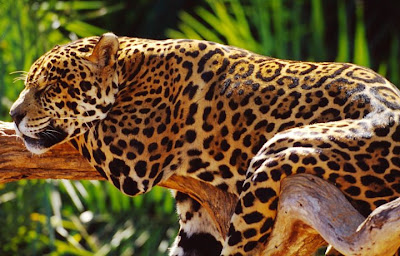The Life of Animals | Panthera onca | animals who have colors that are very beautiful so is malignant, because yes one of those meat-eating animals are very cruel to their prey, many of these animals we encountered on the continent of Europe where there is the most suitable place these animals live. want to know? The following report
The Jaguar is the largest cat in the Western Hemisphere and the third largest cat in the world (after the Lion and the Tiger.) It is also one of the four roaring cats. It differs from a lion's roar and is more of a series of hoarse coughs. It is often confused with the leopard but the Jaguar is a stockier animal. It is usually larger with a broad head and shorter legs and tail. The color is generally a tawny yellow with dark spots on the head and neck and dark rings on the body. Inside these rings there is usually a dark spot.
This is the primary difference between the spots on a Jaguar and the spots on a leopard. There are also black Jaguars. These are usually found in dense forests and are often called Black Panthers. The body length is between 4 and 6 feet and its tail is about 30 inches.
They feed on small preyWhat does prey mean such as the capyabara and the peccarie but will also eat larger animals such as cattle. They will also eat reptiles such as the crocodile and small rodents. It has a very powerful jaw and usually kills its prey with one bite. Its name comes from the South American Indian word "yaguara." This means "a beast that kills its prey with one bound". Unlike most big cats, Jaguars don't kill by biting the neck. They bite through the temporal bones of the skull and kill quickly.
Jaguars are found in tropical rainforests, arid scrub, and wet grasslands. They prefer dense forests or swamps with a ready supply of water. Geographically they are found in the Southwestern United States throughout Central America and into Northern South America.
Except during breeding season, Jaguars are solitaryWhat does solitary mean? creatures. They primarily stay on land although they can swim quite well. They can communicate with various vocal sounds and use scent to mark their territory. They also cannot be classed as diurnal or nocturnal. Depending on the situation and the territory they inhabit, they will do either.














